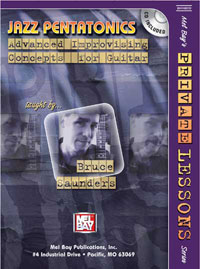« Best of JM: Respect the Silence |
Main
| The Quest for "Playability" »
 July 18, 2013 | Pentatonic Scales; a whole new level! July 18, 2013 | Pentatonic Scales; a whole new level!
 We mentioned this book over six years ago, Berklee professor and Austin, Texas based jazz guitarist Bruce Saunder's book Jazz Pentatonics (Mel Bay Private Lessons Series) as a great source for digging into the concept of advance Pentatonic scale use. Every folk musician knows the power of the pentatonic, five little notes and formulaic traid-plus-benign-notes capability. Mandolinists are prone to imprison themselves to just the simplicity of the Pentatonic scale in the key(s) of the song itself, beginning and most advanced, as well. We mentioned this book over six years ago, Berklee professor and Austin, Texas based jazz guitarist Bruce Saunder's book Jazz Pentatonics (Mel Bay Private Lessons Series) as a great source for digging into the concept of advance Pentatonic scale use. Every folk musician knows the power of the pentatonic, five little notes and formulaic traid-plus-benign-notes capability. Mandolinists are prone to imprison themselves to just the simplicity of the Pentatonic scale in the key(s) of the song itself, beginning and most advanced, as well.
The great Bebop musicians, 'Trane, Diz, Bird, were able to take these scales further, base them on upper extensions of the chords. If you have drilled these scales into your frets, you can take the next step of injecting them into your music as a way of voicing the upper chord extensions of some juicy chords. If you improvise these 5 notes with certain 7th chord variations, you can voice melodically, 9ths, 11ths, and 13ths, without thinking 9ths, 11ths, and 13ths.
Below are sample Pentatonic "opportunities" for Maj7, Min7, Dom7, and m7b57 chords. Especially effective in modal jazz where the song sits on a chord for several measures, these can bend the ear in an interesting but tastefully appropriate way. We've listed the 7th chord variation, the "Old School" Pentatonic scale used, and a new and improved "Upgrade." We've also noted the chord tones you infer by using the particular scale.
One suggestion, have another player comp the chord in a background first, or use some sort of "Band in a Box" software program or iReal B iPad app to generate an accompaniment. Once you get comfortable with one or two chords, play along with some familiar changes like a 12-bar blues or Rhythm Changes.
Open your ears and have fun!
Cmaj7
Old School: C Pentatonic C D E G A
Upgrade: D Pentatonic D E F# A B
You get: 9, (3), +11, 6, 7
Relation to root: Plus one step
Cm7
Old School: Eb Pentatonic (Cm Pentatonic) Eb F G Bb C
Upgrade: Bb Pentatonic Bb C D F G
You get: (7), (1), 9, 11, (5)
Relation to root: Down one step (up m7)
C7
Old School: C Pentatonic C D E G A
Upgrade: Bb Pentatonic Bb C D F G
Better Upgrade: Gb Pentatonic (Alt chord) Gb Ab Bb Db Eb
You get: b5, b13, b7, b9, +9
Relation to root: Plus diminished 5th (tritone)
Cm7b5
Ab Pentatonic Ab Bb C Eb F
You get: b13, b7, (1), (3), 11
Relation to root: Plus m6
Also: FFcP Pentatonic
Further:
Jazzed Pentatonics
Enhanced Pentatonics; What Goes Up Must Come Down.
Pentatonic revisited
Tetrachordal Approach to Major Scale Modes
Lateral Tetrachords
Posted by Ted at July 18, 2013 5:08 AM

Disclaimer: In the 'Information Age' of the 21st Century,
any fool with a computer, a modem, and an idea can
become a self-professed 'expert." This site does not
come equipped with 'discernment.'
|



